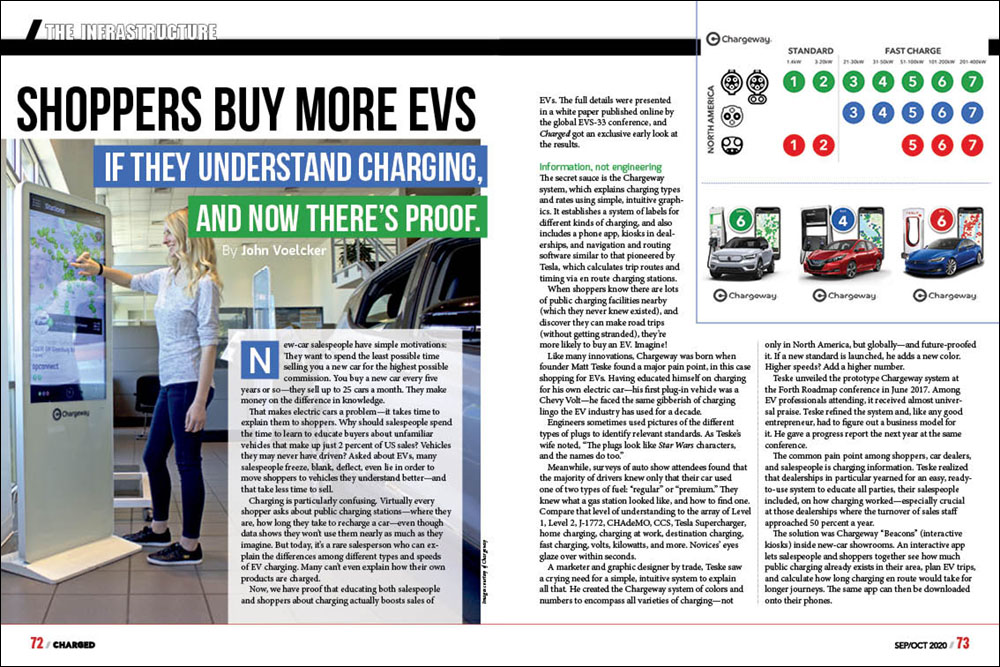New-car salespeople have simple motivations: They want to spend the least time selling you a new car for the highest possible commission. You buy a new car every five years or so; they sell up to 25 cars a month. They make money on the difference in knowledge.
That makes electric cars a problem: they take time to explain to shoppers. Why should salespeople spend the time to learn educate shoppers on unfamiliar vehicles that make up just 2 percent of US sales? Vehicles they may never have driven? Asked about EVs, many salespeople freeze, blank, deflect, even lie to move shoppers to vehicles they understand better—and that take less time to sell.
Charging is particularly confusing. Virtually every shopper asks about public charging stations—where they are, how long they take to recharge a car—even though data shows they won’t use them nearly as much as they imagine. But today, it’s a rare salesperson who can explain the differences among different types and speeds of EV charging. Many can’t even explain how their own products are charged.
Now, we have proof that educating both salespeople and shoppers about electric-car charging actually boosts sales of EVs. The full details will be presented in September, in a white paper published online by the global EVS-33 conference. But Charged got an exclusive early look at the results.
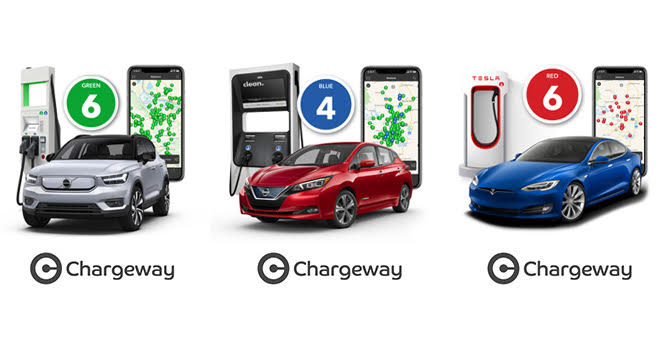
Information, not engineering
The secret sauce is the Chargeway system, which explains charging types and rates using simple, intuitive graphics. It establishes a system of labels for different kinds of charging, and also includes a phone app, kiosks in dealerships, and navigation and routing software similar to that pioneered by Tesla that calculates trip routes and timing via en-route charging stations.
When shoppers know there’s lots of public charging nearby (which they never knew existed), and discover they can make road trips (without getting stranded), they’re more likely to buy an EV. Imagine!
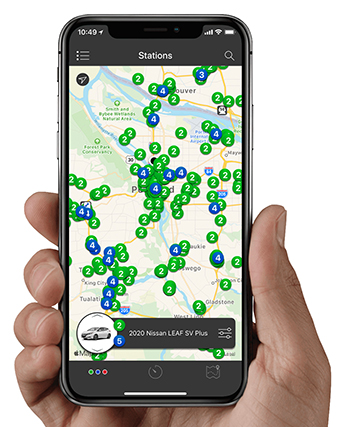
Like many innovations, Chargeway was born when founder Matt Teske found a major pain point, in this case shopping for EVs. Having educated himself on charging for his own electric car—his first plug-in vehicle was a Chevy Volt—he faced the same gibberish of charging lingo the EV industry has used for a decade.
Engineers sometimes used pictures of the different types of plugs to identify relevant standards. As Teske’s wife noted, “The plugs look like like Star Wars characters, and the names do too.”
Meanwhile, surveys of auto show attendees found that the majority of drivers knew only that their car used one of two fuels: “regular” or “premium.” They knew what a gas station looked like, and how to find one. Compare that level of understanding to the array of Level 1, Level 2, J-1772, CHAdeMO, CCS, Tesla Supercharger, home charging, charging at work, destination charging, fast charging, volts, kilowatts, and more. Novices’ eyes glaze over within seconds.
A marketer and graphic designer by trade, Teske saw a crying need for a simple, intuitive system to explain all that. He created the Chargeway system of colors and numbers to encompass all varieties of charging—not only in North America, but globally—and future-proofed it. If a new standard launches, he adds a new color. Higher speeds? Add a higher number.
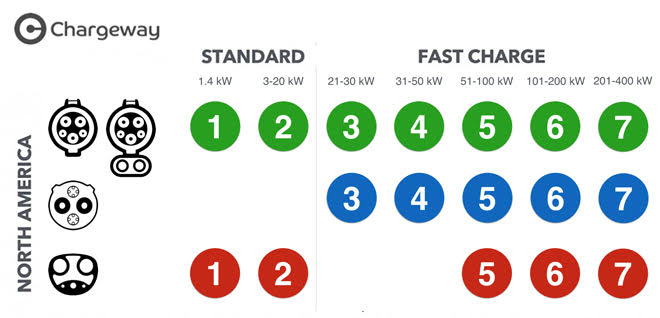
Teske unveiled the prototype Chargeway system at the Forth Roadmap conference in June 2017. Among EV professionals attending, it received almost universal praise. Teske refined the system and, like any good entrepreneur, had to figure out a business model behind it. He gave a progress report the next year at the same conference.
The common pain point among shoppers, car dealers, and salespeople is charging information. Teske realized dealerships in particular yearned for an easy, ready-to-use system to educate all parties, their salespeople included, on how charging worked—especially crucial at those dealers where the turnover of sales staff approached 50 percent a year.
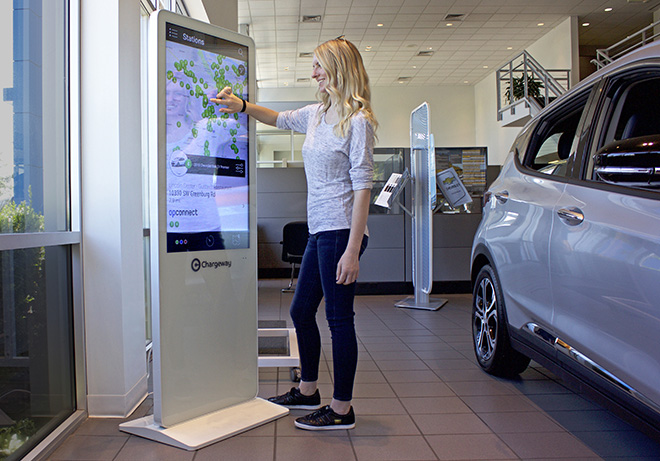
The solution was Chargeway “Beacons” (interactive kiosks) inside new-car showrooms. An interactive app lets salespeople and shoppers together see how much public charging already exists in their area, plan EV trips, and calculate how long charging en route would take for longer journeys. The same app can then be downloaded onto their phones.
Lots of talk
For 18 months, Teske talked about Chargeway to anyone and any group that would listen. State dealer associations liked the kiosk idea, since it solved a problem for their members. Electric utilities came to appreciate the idea at varying paces, as utilities don’t historically have to do much marketing to consumers. Most automakers thought it was interesting—especially their EV teams—and waited for greater adoption before committing to anything.
One nice thing about Oregon is that it’s progressive, but also small enough that new ideas can actually move through state government. As Jeff Allen, Executive Director of Forth Mobility, said in 2015, “We tend to collaborate really well across companies and government, and we have a history of innovative, supportive public policy.”
One crucial partner was the Oregon Department of Transportation (ODoT). By allowing Chargeway to place its graphic logos on the new and existing charging sites ODoT was involved in, roughly one fifth of the state’s public charging infrastructure now has the big colored circles with numbers inside that appear in the Chargeway app.
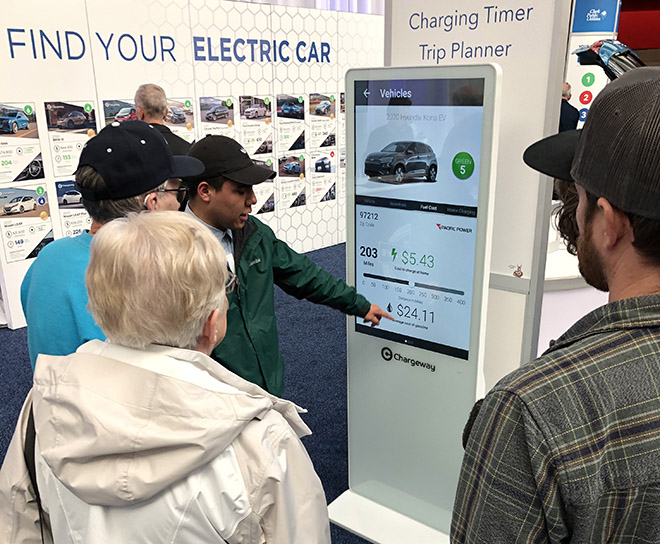
However, hard data and proof of results were needed to expand Chargeway beyond Oregon. Teske had talked to dozens, if not hundreds, of organizations, agencies, utilities and carmakers. Quite reasonably, most said, “OK, it sounds great. Now go prove it actually gets more EVs on the road.”
In January 2019, Chargeway launched a pilot project with two utilities, Portland General Electric and Pacific Power. Other partners included Forth, various state agencies (including ODoT)—and most importantly, the Oregon Auto Dealers Assocation (OADA).
Chargeway beacons (kiosks) would be deployed at up to a dozen dealerships around Oregon, coordinated with messaging and marketing efforts from the local utilities. Teske and his team trained dealership personnel on how to use the beacons, complete with role-playing to make answering questions on charging easy, quick and intuitive.
Two to 10 times as many EVs sold
Fourteen months later, seven Beacons were up and running in dealerships. The results were clear: EV sales in dealerships with a Chargeway beacon had risen by 2 to 10 times compared to those at dealers with similar inventories of EVs but no beacons.
On average, the beacons were used 1.5 to 2 times per day at the dealers. The highest usage came at the Forth EV Showcase in downtown Portland, which sees substantial foot traffic. Overall, beacons in the metro Portland area were activated 1.5 to 4 times a day.
Chargeway restricted its beacons to dealers that had 5 to 10 EVs in inventory, meaning that EV sales could be completed as quickly as any others, without having to request a vehicle for delivery. Among beacon-equipped dealers, Wilsonville Chevrolet (15 miles outside Portland) sold four times as many EVs as other Chevy dealers with similar inventory of Volts and Bolt EVs.
Perhaps the best proof of Chargeway’s impact has come from salespeople who are deeply relieved that they can take advantage of the beacons’ guidance, right alongside the customers they’re trying to sell to. In late August, a Hyundai salesperson handed a note to the Chargeway rep who had just trained him on how to use the beacon going into his dealership.
“I will now be able to sell twice as many EVs in a day due to how much time the Beacon saves that I spend researching & answering detailed charging questions. Thank you for designing this extremely user-friendly device to help our dealership & many others! Thanks again! Dav at Hyundai.”
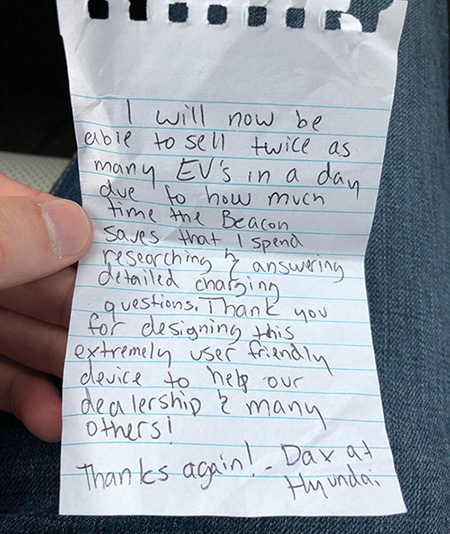
Then came COVID
Teske was scheduled to present a 12-page white paper covering the results at the annual Forth Roadmap conference in June 2020. This year, Roadmap was combined with the huge global EVS conference, held in Portland for the first time. It provided a global audience for Chargeway’s first proof that it increased EV sales.
Then came the Covid-19 pandemic. The combined Roadmap-EVS conference had to be canceled.
Now the Chargeway white paper will be published in full by EVS-33 in September. After that, Teske will hit the (virtual) road, presenting the findings to relevant associations, trade groups, consumer-education initiatives, and more.
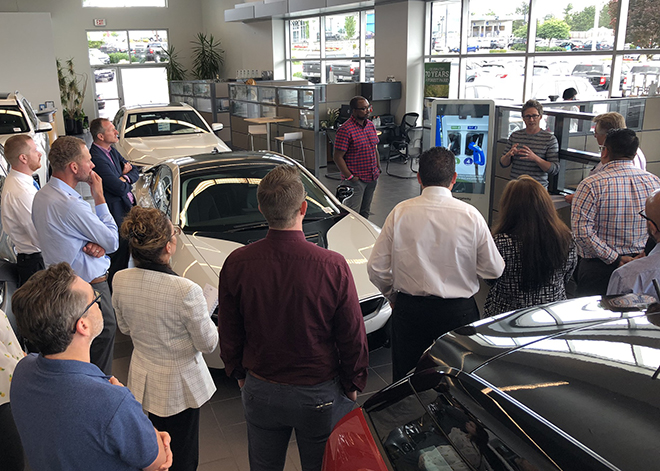
While COVID denied Chargeway an in-person audience of thousands, Teske says it offered at least one benefit: auto dealers are now working far harder on digital tools to do more of their business outside showrooms. Chargeway has every intention of being part of those efforts. “We’re working on this product roadmap” right now, Teske told Charged.
Unsurprisingly, Beacon usage plummeted along with showroom traffic during the spring shutdown. But in July, Teske says, usage returned to its pre-COVID levels, and Chargeway is continuing efforts to expand outside its Oregon base.
The company had already deployed beacons in Indiana, Texas, and Washington state. Those efforts are resuming, and discussions are underway for similar programs in several more states.
Chargeway is also talking with utilities in those areas and others, as well as dealership groups and associations. The negotiations bring together partners who may never have worked together—auto dealer trade groups and electric utilities, for example—to join forces in a new type of digital effort to sell a new type of product. That takes time.
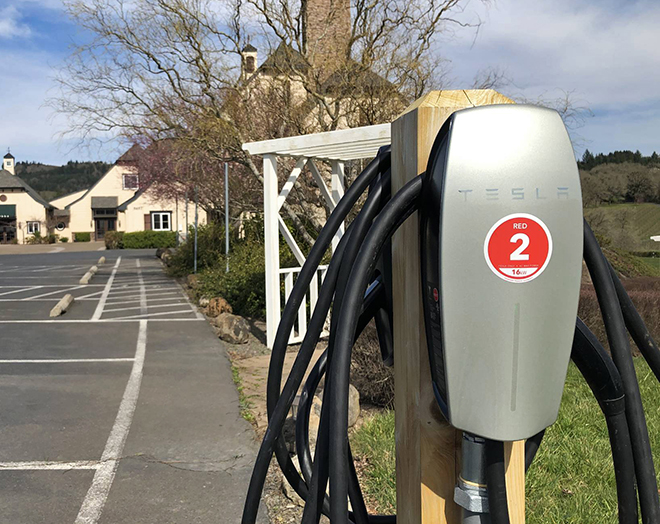
Next stop: EV dashboards?
Given the impact of COVID on the dealerships carmakers need to sell their vehicles—especially high-effort electric cars—Teske says Chargeway is now seeing increased interest from car companies that understand they must focus on every step of the EV sales process.
In fact, he said, Chargeway is in discussion with six EV-makers (Audi, BMW, Ford, Jaguar, Lucid and Volvo) about ways they might work more closely together. Those could include licensing the company’s software to integrate not only into their vehicles but across multiple online, retail, and mobile touchpoints for both new-car shoppers and existing owners.
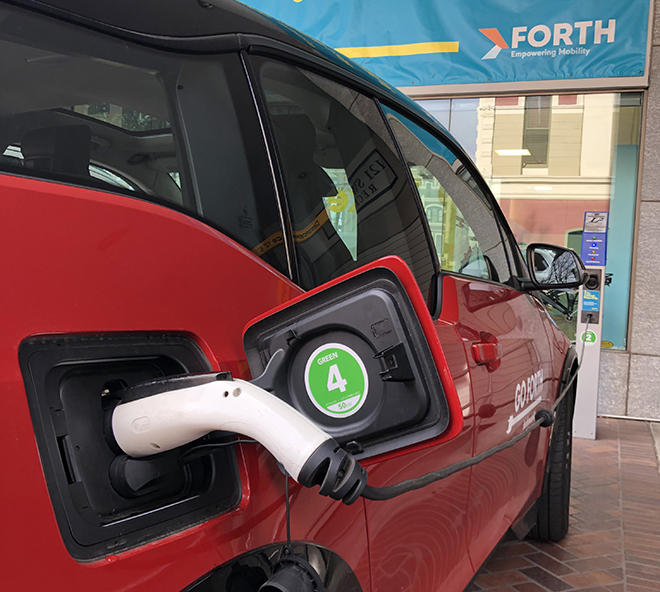
Despite the virus-imposed pause, Teske remains optimistic about the long-term benefits of Chargeway. More testing will be needed, with a broader array of dealers, brands, and locations, but he’s confident the concept has proven itself. That confidence comes from what he’d felt all along, now confirmed by this first study: better, easier-to-understand information on EV charging does in fact sell more EVs.
It may sound obvious, but it took a graphic designer with a keen eye for marketing who’s a car fanatic, an EV driver, and concerned about climate change to figure out how to do it.
The full Chargeway white paper, Evaluating the Effectiveness of the Chargeway Oregon Program, will be available online on from EVS-33 in September.







